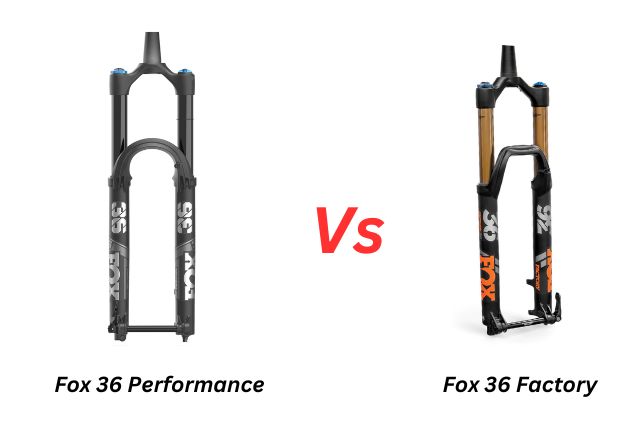
The Fox 36 fork is one of the most popular and versatile suspension forks on the market, offering a range of options for different riding styles and terrains.
But how do you choose between the Performance and Factory versions of the Fox 36? What are the main differences and benefits of each one?
Below, we will compare the Fox 36 Performance and Factory forks, looking at their features, specifications, performance and price.
Features
The Fox 36 Performance and Factory forks share the same chassis, air spring and travel options (150mm or 160mm). They also have the same 15x110mm Boost axle, 44mm offset and tapered steerer tube. The main difference between them is the damper and the stanchion coating.
Fox 36 Performance
The Fox 36 Performance fork uses a GRIP damper, which is a simple and reliable system that offers three compression settings (Open, Medium and Firm) and a wide range of rebound adjustment. The GRIP damper uses a sealed cartridge design that reduces friction and improves durability.
Fox 36 Factory
The Fox 36 Factory fork uses a GRIP2 damper, which is a more advanced and adjustable system that offers four-way independent adjustment of high-speed and low-speed compression and rebound.
The GRIP2 damper uses a Variable Valve Control (VVC) technology that allows for finer tuning of the damping curves. The GRIP2 damper also has a patented closed cartridge bladder design that reduces friction, improves consistency and prevents cavitation.
Stanchion coating
Performance fork has black anodized stanchions, while the Factory fork has gold Kashima-coated stanchions. The Kashima coating is a hard anodized layer that reduces friction, improves smoothness and increases durability.
Read Also: Fox Performance vs. Performance Elite
Specifications
Here are some of the key specifications of the Fox 36 Performance and Factory forks:
| Feature | Performance | Factory |
|---|---|---|
| Travel | 150mm or 160mm | 150mm or 160mm |
| Wheel size | 27.5″ or 29″ | 27.5″ or 29″ |
| Axle | 15x110mm Boost | 15x110mm Boost |
| Offset | 44mm | 44mm |
| Steerer | Tapered | Tapered |
| Damper | GRIP | GRIP2 |
| Compression adj. | Open/Medium/Firm | HSC/LSC |
| Rebound adj. | LSR | HSR/LSR |
| Stanchion coating | Black anodized | Kashima-coated |
| Weight (29″, 160mm) | 2,030g | 1,996g |
| Price (MSRP) | $849 / £899 / €999 / AU$1,499 | $1,069 / £1,099 / €1,299 / AU$1,899 |
Performance
Both the Performance and Factory forks offer excellent performance on the trail, but they have different characteristics and strengths.
Performance fork
The Performance fork is a great choice for riders who want a simple, reliable and easy-to-set-up fork that can handle a variety of terrain and conditions. The GRIP damper offers a good balance of support, traction and comfort, with enough adjustability to fine-tune the feel.
The Open mode is plush and responsive, the Medium mode adds some extra support for pedaling efficiency, and the Firm mode locks out the fork for smooth surfaces. The rebound adjustment allows for further customization of the fork’s behavior.
Read Also: SunTour XCT vs. RockShox Judy: Compared
Factory fork
The Factory fork is a great choice for riders who want a more sophisticated, precise and tunable fork that can adapt to different riding styles and preferences. The GRIP2 damper offers a high level of control, sensitivity and adjustability, with four independent circuits that allow for detailed manipulation of the damping curves.
The high-speed and low-speed compression adjustments let you dial in the fork’s support, stability and bottom-out resistance, while the high-speed and low-speed rebound adjustments let you control the fork’s recovery speed, traction and feedback. The VVC technology makes it easier to adjust the high-speed damping without affecting the low-speed damping.
The Kashima coating on the Factory fork also adds some extra smoothness and durability to the fork’s performance. The Kashima coating reduces friction between the stanchions and seals, resulting in less stiction, more sensitivity and longer service intervals.
Price
The Factory fork is more expensive than the Performance fork by about $220 / £200 / €300 / AU$400. This reflects the higher level of technology, adjustability and quality that the Factory fork offers. However, both forks are still within a reasonable price range for high-end suspension forks.
Read Also: Marzocchi Bomber Z2 vs. Fox 34
Conclusion
The Fox 36 Performance and Factory forks are both excellent options for trail and enduro riders who want a capable, versatile and high-performance fork.
The Performance fork is more suited for riders who value simplicity, reliability and ease of use, while the Factory fork is more suited for riders who value sophistication, precision and tunability.
